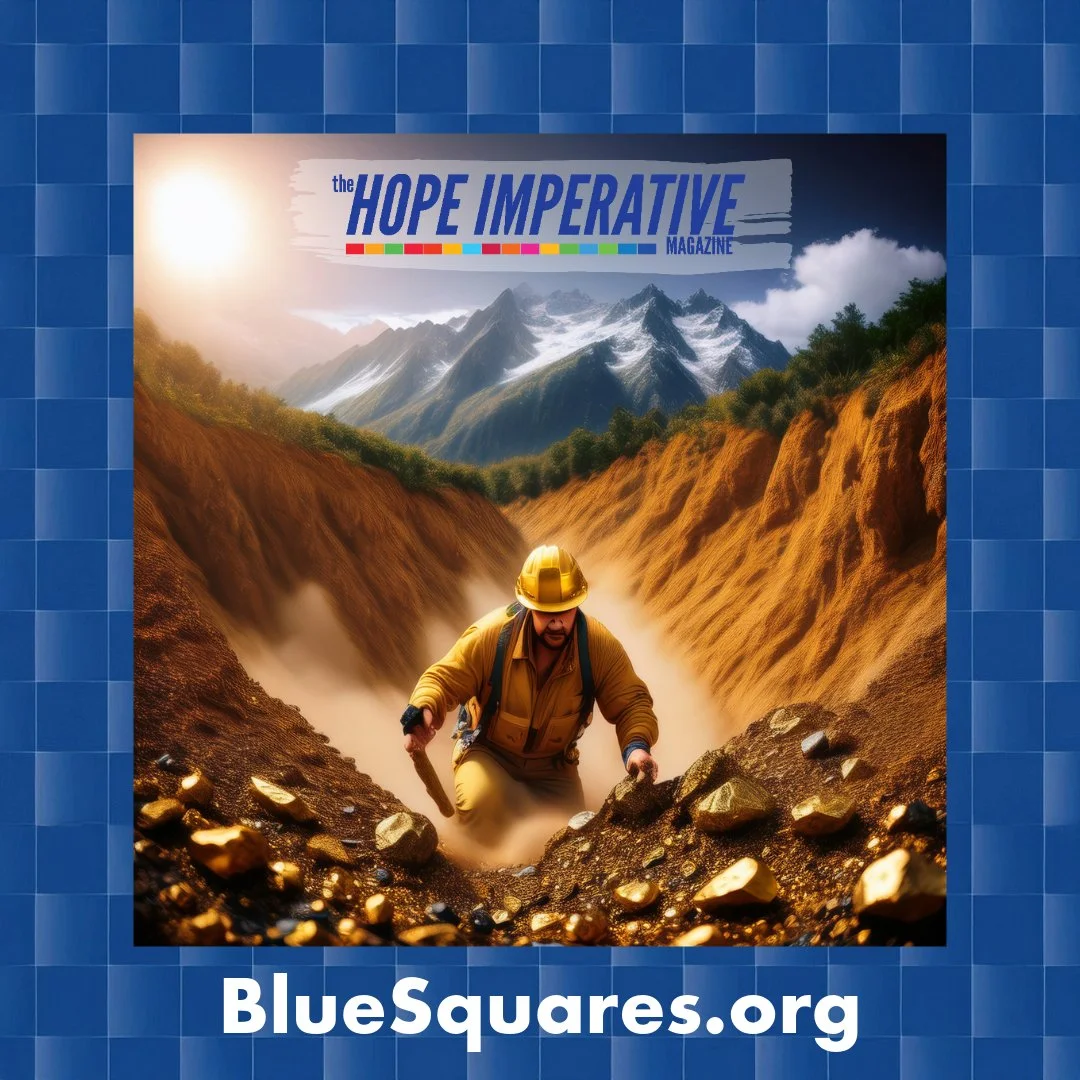Unearthing Hope: Humanity’s Most Valuable Natural Resource
Executive Summary
Throughout history, humans have tirelessly pursued precious resources—gold, diamonds, oil—investing enormous amounts of energy, time, and capital to transform these elements from their raw, unrefined states into polished, coveted commodities. Similarly, hope is an intangible yet indispensable natural resource that resides deeply embedded within humanity itself. Initially indistinguishable, raw, rough, and seemingly unattractive, hope demands a comparably rigorous and meticulous process to identify, extract, and refine. Crucially, only humans possess the unique capacity to unearth and polish hope, transforming it into a potent force capable of fostering resilience, inspiring progress, and sustaining the long-term growth of societies.
Introduction
From ancient empires prospecting for gold to modern societies exploring rare-earth minerals, humanity's relentless pursuit of valuable resources mirrors an intrinsic drive toward security, advancement, and prosperity. Raw materials such as gold and diamonds initially emerge in crude, dull, and seemingly worthless forms, their true value concealed beneath layers of dirt and impurity. It is solely through human intervention—intense labor, specialized knowledge, advanced technology, and significant investment—that these natural elements become refined, cherished assets.
This white paper explores the analogous nature of hope, often misunderstood or underestimated due to its intangible character. Hope mirrors traditional resources in its raw, hidden, and seemingly unimpressive initial form. Yet, its cultivation through human compassion and deliberate action transforms hope into a priceless, impactful asset for society, meriting intentional, structured investment.
Defining Hope as a Resource
Hope, the positive anticipation and earnest desire for beneficial outcomes, is frequently overlooked despite its profound influence on human progress (Snyder, 2002). The United Nations’ Sustainable Development Goals (SDGs) implicitly recognize hope as fundamental, embedding it in their framework as a critical driver behind global collaboration, sustainability, and meaningful change (UNDP, 2020).
Like gold or diamonds, raw hope often presents as indistinguishable and unimpressive, hidden beneath layers of despair, disillusionment, fear, and indifference. The transformative power of hope emerges only through conscious, sustained human efforts—grounded in empathy, compassion, education, and structured community investment (Fredrickson, 2009).
The Extraction and Refinement of Hope
Extracting precious resources demands sophisticated technology, significant economic resources, and persistent effort. Similarly, uncovering and refining hope requires dedicated exploration, psychological understanding, community engagement, and sustained societal investment.
Exploration: Identifying Hope
Identifying hope requires a nuanced and compassionate exploration of the human condition. Psychological research highlights that hopefulness can be intentionally fostered even under severe adversity (Seligman, 2011). Initially, hope may manifest subtly or negatively—appearing as apathy or despair—requiring considerable discernment to recognize its latent potential, similar to the initial exploratory processes in mining.
Extraction: Unearthing Hope
Extracting hope involves purposeful actions aimed at cultivating emotional intelligence, community resilience, and collective optimism. This stage demands patience and significant resources, akin to mining practices. Community development programs, educational curricula focusing on resilience, and robust mental health infrastructure are essential tools for this extraction (Lyubomirsky, 2007).
Refinement: Transforming Hope
Refining hope parallels the careful cutting, polishing, and shaping processes used in gem refinement. Humans uniquely refine hope through compassionate leadership, education, mentoring, therapeutic interventions, and supportive policy structures (Fredrickson & Joiner, 2002). This refinement process highlights humanity’s exclusive capability: no other force can convert raw hope into the polished, influential, and beautiful resource humanity desires and relies upon.
Economic and Social Impacts of Hope
Hope significantly influences societal well-being, economic stability, innovation, and community cohesion. Economically hopeful populations exhibit heightened creativity, enhanced productivity, greater adaptability, and resilience against economic downturns (Gallup, 2020). Socially, hope reinforces community bonds, mitigates conflicts, and fosters long-term stability and sustainability.
Canadian mental health initiatives provide compelling evidence of hope’s socioeconomic benefits, demonstrating substantial improvements in public health outcomes, reduced healthcare expenditures, and increased community stability (Mental Health Commission of Canada, 2021).
Case Studies
Canada's Indigenous Communities
Canadian Indigenous communities highlight the transformative power of hope through initiatives focused on cultural revival, education, mental health, and community empowerment. Programs that restore cultural identity, encourage self-determination, and strengthen community pride reflect humanity’s capacity to refine hope from raw potential into actionable societal change (Truth and Reconciliation Commission, 2015).
Global Mental Health Initiatives
The World Health Organization’s Mental Health Action Plan demonstrates hope’s global value, systematically integrating mental health interventions with sustainable development goals. These efforts underscore hope's transformative impact on global health, resilience, and sustainable growth (WHO, 2013).
Strategic Recommendations
Prioritize hope-focused frameworks in national and global educational, healthcare, and social policies to systematically foster resilience and optimism.
Allocate specific, sustained investments towards programs aimed at extracting and refining hope, particularly in marginalized or disadvantaged communities.
Facilitate interdisciplinary collaborations between policymakers, educators, healthcare professionals, psychologists, and community leaders to optimize the management and refinement of hope as a resource.
Conclusion
Recognizing hope as a resource of comparable significance to gold and diamonds elevates its strategic importance, prompting structured investment and dedicated refinement. The human capacity to transform hope from its raw, indistinct form into a refined, potent resource underscores humanity’s unique role in nurturing societal resilience and sustainable growth. Hope's immense power to inspire, heal, and transform communities demands thoughtful, compassionate, and sustained human engagement.
References
Fredrickson, B. L. (2009). Positivity: Groundbreaking Research Reveals How to Embrace the Hidden Strength of Positive Emotions. Crown Publishing Group.
Fredrickson, B. L., & Joiner, T. (2002). Positive emotions trigger upward spirals toward emotional well-being. Psychological Science, 13(2), 172-175.
Gallup. (2020). State of the Global Workplace Report. Gallup Press.
Lyubomirsky, S. (2007). The How of Happiness: A New Approach to Getting the Life You Want. Penguin.
Mental Health Commission of Canada. (2021). Annual Report 2020-2021. Retrieved from https://www.mentalhealthcommission.ca
Seligman, M. E. P. (2011). Flourish: A Visionary New Understanding of Happiness and Well-being. Free Press.
Snyder, C. R. (2002). Hope Theory: Rainbows in the Mind. Psychological Inquiry, 13(4), 249-275.
Truth and Reconciliation Commission of Canada. (2015). Final Report of the Truth and Reconciliation Commission of Canada. Retrieved from http://www.trc.ca
United Nations Development Programme (UNDP). (2020). The Sustainable Development Goals Report 2020. Retrieved from https://unstats.un.org/sdgs/report/2020/
World Health Organization (WHO). (2013). Mental Health Action Plan 2013-2020. Retrieved from https://www.who.int/publications/i/item/9789241506021

